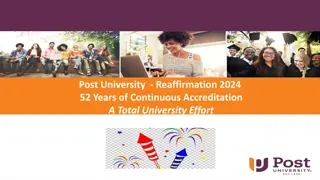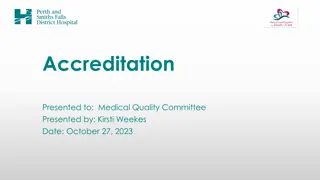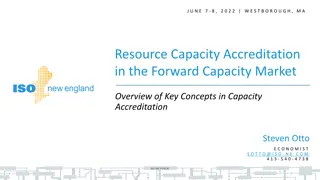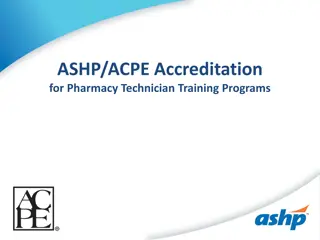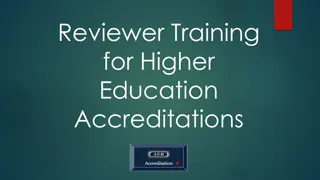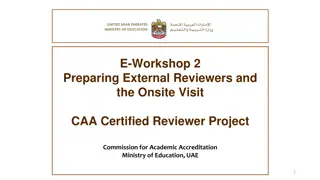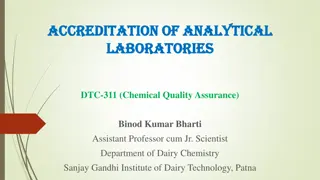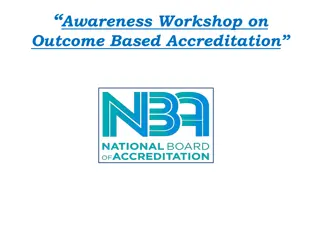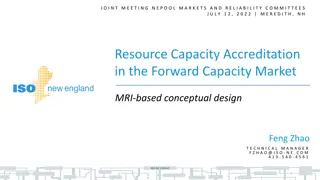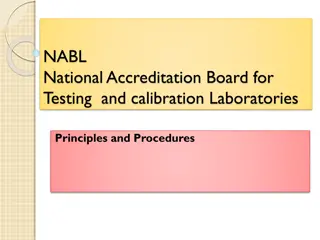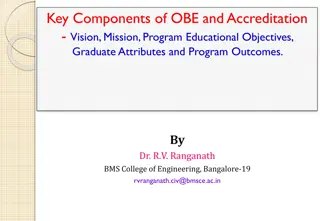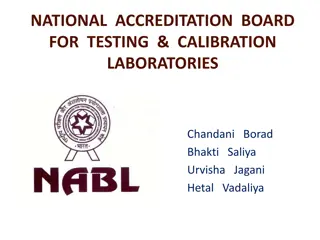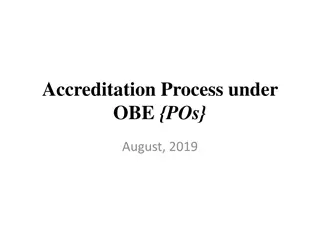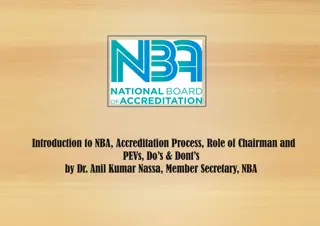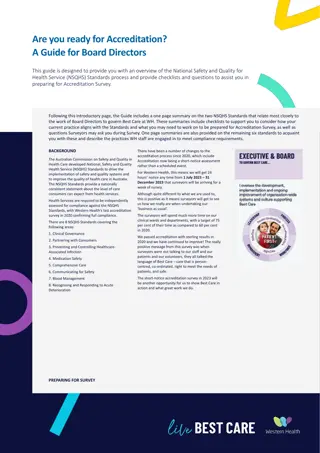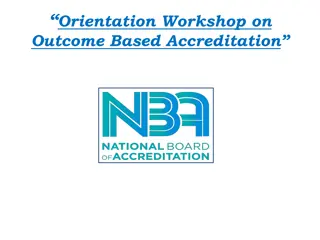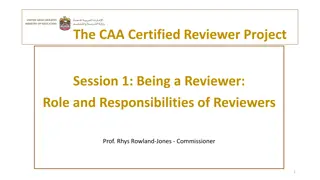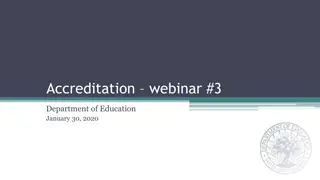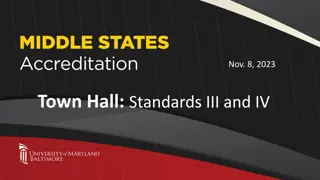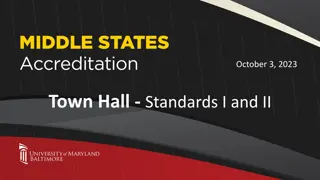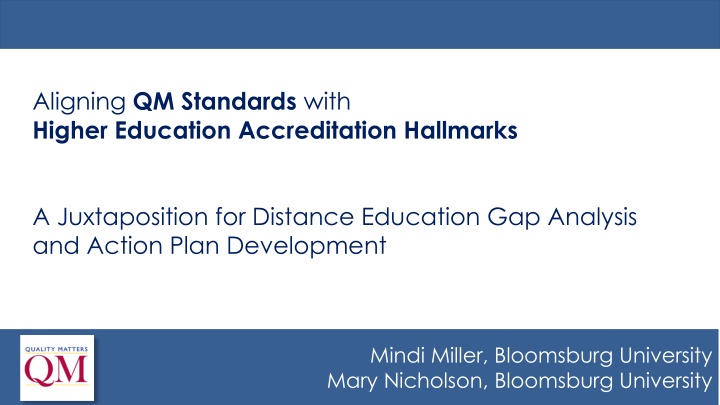
Alignment of Quality Matters Standards with Higher Education Accreditation Hallmarks
Explore the alignment of Quality Matters standards with higher education accreditation hallmarks in distance education, focusing on gap analysis and action plan development. Includes case studies, gap analysis templates, and standards for distance education, enhancing quality in online learning.
Download Presentation

Please find below an Image/Link to download the presentation.
The content on the website is provided AS IS for your information and personal use only. It may not be sold, licensed, or shared on other websites without obtaining consent from the author. If you encounter any issues during the download, it is possible that the publisher has removed the file from their server.
You are allowed to download the files provided on this website for personal or commercial use, subject to the condition that they are used lawfully. All files are the property of their respective owners.
The content on the website is provided AS IS for your information and personal use only. It may not be sold, licensed, or shared on other websites without obtaining consent from the author.
E N D
Presentation Transcript
Aligning QM Standards with Higher Education Accreditation Hallmarks A Juxtaposition for Distance Education Gap Analysis and Action Plan Development Mindi Miller, Bloomsburg University Mary Nicholson, Bloomsburg University
Case Study State System University Taming the Wild West of DE
Overview Gap analysis based on standards Alignment of standards Recommendations from the findings Action plans fostering DE quality
Gap analysis based on standards Alignment of standards Recommendations from the findings Action plans fostering DE quality
Gap Analysis Template Hallmark Standard Hallmark Standard 1: Mission and purposes Hallmark Standard 2: Sustainability Hallmark Standard 3: Governance Hallmark Standard 4: Academic Rigor Hallmark Standard 5: Evaluation Hallmark Standard 6: Qualified Faculty Hallmark Standard 7: Student Support Hallmark Standard 8: Resources Hallmark Standard 9: Academic Integrity Gap Analysis Unclear DE mission and vision Evidence driven Initiatives DE committee formed No formalized organizational structure Proposed Center for Online Learning Master course syllabi with a methods section exists Specific wording proposed to show equivalent rigor and evaluation of both online and F2F courses No consistent faculty training for teaching online Online orientation tutorials required for freshman students Resources available through the LMS and support services Professional development opportunities expanded Expand online assistance for all students Policies will be revised to include DE Policies do not explicitly reference DE
Standards for Distance Education Focused on the Institution Centered on the Learner
Hallmark Standard 1 General Standard 2 Learning Objectives (Competencies) Online learning is appropriate to the institution s mission and purpose. Learning objectives or competencies describe what learners will be able to do upon completion of the course.
Hallmark Standard 2 General Standard 8 Accessibility and Usability The institution's plans for developing, sustaining, and, if appropriate, expanding online learning offerings are integrated into its regular planning and evaluation processes. The course design reflects a commitment to accessibility and usability for all learners.
Hallmark Standard 3 General Standard 7 Learner Support Online learning is incorporated into the institution s system of governance and academic oversight. The course facilitates learner access to institutional support services essential to learner success.
Hallmark Standard 4 General Standard 1 Course Overview and Introduction Curricula for the institution s online learning offerings are coherent, cohesive, and comparable in academic rigor to programs offered in traditional instructional formats. The overall design of the course is made clear to the learner at the beginning of the course.
Hallmark Standard 5 General Standard 3 Assessment and Measurement The institution evaluates the effectiveness of its online learning offerings, including the extent to which the online learning goals are achieved, and uses the results of its evaluations to enhance the attainment of the goals. Assessments are integral to the learning process and are designed to evaluate learner progress in achieving the state learning objectives or mastering the competencies.
General Standard 4 Instructional Materials Hallmark Standard 6 Faculty responsible for delivering the online learning curricula and evaluating the students success in achieving the online learning goals are appropriately qualified and effectively supported. Instructional materials enable learners to achieve state learning objectives or competencies. General Standard 5 Learning Activities and Learner Interaction Learning activities facilitate and support learners interaction and engagement.
Hallmark Standard 7 General Standard 7 Learner Support The institution provides effective student and academic services to support students enrolled in online learning offerings. The course facilitates learner access to institutional support services essential to learner success.
Hallmark Standard 8 General Standard 6 Course Technology The institution provides sufficient resources to support and, if appropriate, expand its online learning offerings. Course technologies support learner s achievement of course objectives or competencies.
Hallmark Standard 9 General Standard 8 Accessibility and Usability The institution assures the integrity of its online offerings. The course design reflects a commitment to accessibility and usability for all learners.
Gap analysis based on standards Alignment of standards Recommendations from the findings Action plans fostering DE quality
Hallmark Standard 1: Mission and purposes Mission: Distance Education contributes to our mission for student success through an inclusive online community that meets diverse learning needs. Vision: Distance Education will provide seamless access to high- quality education (effective, affordable, accessible) and safe environments for learning by: Incorporating new and emerging technologies Delivering high quality courses and programs Supporting students and faculty with resources and training
Hallmark Standard 2: Sustainability Hallmark Standard 3: Governance Director Center for Distance Learning Distance Education Committee Student Support Services Technology Support Student Support Faculty Support Instructional Media Support Compliance SARA, Middle States, DE Instructional Design Instructional Designer College of Science Video/Audio Support LMS Administrator Instructional Designer College of Liberal Arts Help Desk Video/Audio Production Hardware/Software Support Instructional Designer College of Education Instructional Designer College of Business
Hallmark Standard 4: Academic Rigor Hallmark Standard 5: Evaluation Excerpts from Master Course Syllabus The objectives, content, resources, activities, and assignments are the same for both the Distance Education and on site versions of the course. Teaching methods for this course (F2F or DE) can include presentations, demonstrations, and guided practice. Learning activities and assignments (F2F or DE) can include discussions, assigned readings, written assignments, case studies, research, small group activities, team-based projects, student presentations, practice exercises, projects, quizzes, and a final exam.
Hallmark Standard 6: Qualified Faculty Professional Development APPQMR Brown Bag Sessions Teaching Online Certification Course
Hallmark Standard 7: Student Support Orientation course and tutorials Student Help Desk Technology Support Services 24/7 D2L and Zoom support
Hallmark Standard 8: Resources Hallmark Standard 9: Academic Integrity Instructional Media Design Center
Summary Gap analysis Standards Recommendations Action plans

